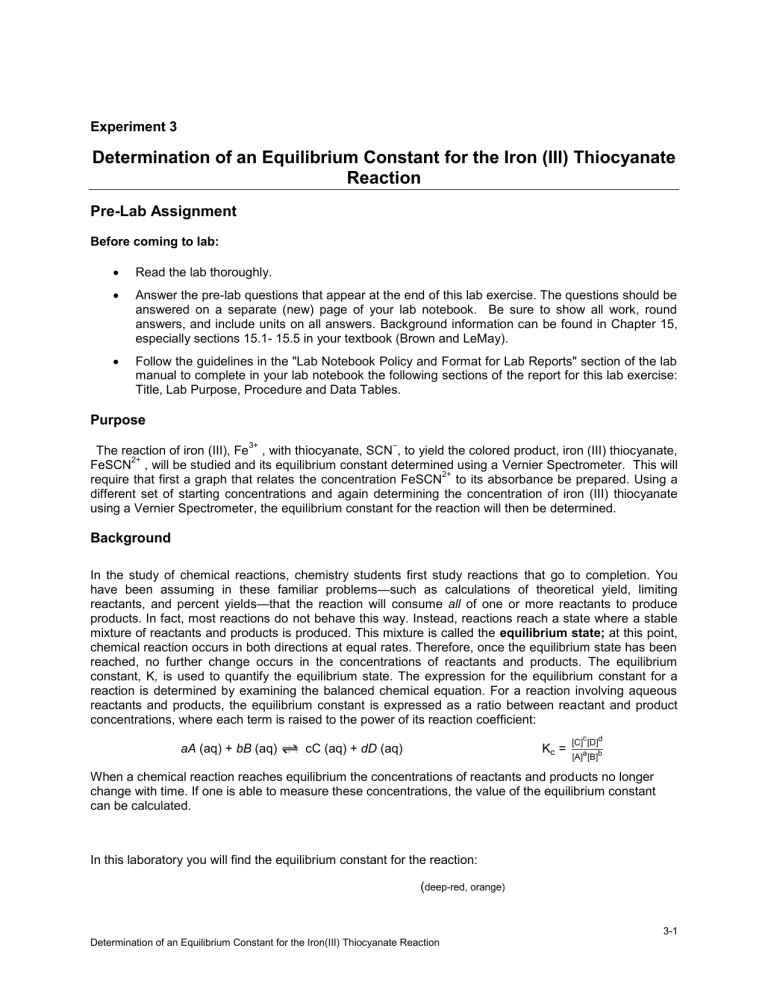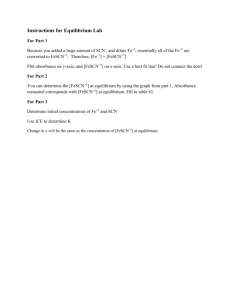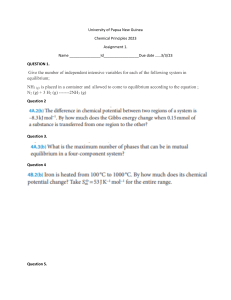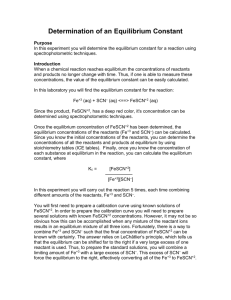
Experiment 3 Determination of an Equilibrium Constant for the Iron (III) Thiocyanate Reaction Pre-Lab Assignment Before coming to lab: Read the lab thoroughly. Answer the pre-lab questions that appear at the end of this lab exercise. The questions should be answered on a separate (new) page of your lab notebook. Be sure to show all work, round answers, and include units on all answers. Background information can be found in Chapter 15, especially sections 15.1- 15.5 in your textbook (Brown and LeMay). Follow the guidelines in the "Lab Notebook Policy and Format for Lab Reports" section of the lab manual to complete in your lab notebook the following sections of the report for this lab exercise: Title, Lab Purpose, Procedure and Data Tables. Purpose 3+ – The reaction of iron (III), Fe , with thiocyanate, SCN , to yield the colored product, iron (III) thiocyanate, 2+ FeSCN , will be studied and its equilibrium constant determined using a Vernier Spectrometer. This will 2+ require that first a graph that relates the concentration FeSCN to its absorbance be prepared. Using a different set of starting concentrations and again determining the concentration of iron (III) thiocyanate using a Vernier Spectrometer, the equilibrium constant for the reaction will then be determined. Background In the study of chemical reactions, chemistry students first study reactions that go to completion. You have been assuming in these familiar problems—such as calculations of theoretical yield, limiting reactants, and percent yields—that the reaction will consume all of one or more reactants to produce products. In fact, most reactions do not behave this way. Instead, reactions reach a state where a stable mixture of reactants and products is produced. This mixture is called the equilibrium state; at this point, chemical reaction occurs in both directions at equal rates. Therefore, once the equilibrium state has been reached, no further change occurs in the concentrations of reactants and products. The equilibrium constant, K, is used to quantify the equilibrium state. The expression for the equilibrium constant for a reaction is determined by examining the balanced chemical equation. For a reaction involving aqueous reactants and products, the equilibrium constant is expressed as a ratio between reactant and product concentrations, where each term is raised to the power of its reaction coefficient: aA (aq) + bB (aq) cC (aq) + dD (aq) When a chemical reaction reaches equilibrium the concentrations of reactants and products no longer change with time. If one is able to measure these concentrations, the value of the equilibrium constant can be calculated. In this laboratory you will find the equilibrium constant for the reaction: (deep-red, orange) 3-1 Determination of an Equilibrium Constant for the Iron(III) Thiocyanate Reaction +3 Fe – (aq) + SCN (aq) FeSCN +2 (aq) 2+ Since the product, FeSCN , has a deep red color, its concentration can be determined using spectrophotometric techniques-that is, based on how much light is its absorbing. +2 Once the equilibrium concentration of FeSCN has been determined, the equilibrium concentrations of 3+ – 3+ the reactants (Fe and SCN ) can be calculated. Because the stoichiometry is 1 mol Fe : 1 mol SCN :1 +3 – mol FeSCN , the moles of each reactant used up (Fe and SCN ) in the reaction is equal to the moles 2+ of product formed (FeSCN ). Since you will know the initial concentrations of the reactants and the amount used up in the reaction, you will be to subtraction to find the moles of reactant remaining at equilibrium. Finally, once you know the concentration of each substance in the reaction, you can calculate the equilibrium constant, where In this experiment you will carry out the reaction several times, each time combining different amounts of 3+ – the reactants, Fe and SCN . The experimental equilibrium constant will then be found by averaging the results from all the trials. Before you do this, however, you will need to determine the relationship between the absorbance and 2+ molarity of [FeSCN ]-a calibration curve. You will do this by measuring the absorbance of five standard 2+ solutions in which [FeSCN ] is known. There is a problem here. How can you know the concentrations 2+ 3+ of FeSCN formed in the reaction? After all, it is an equilibrium reaction so not all of the Fe and SCN 2+ will turn into FeSCN . In other words, unlike in Chem1A, mixing known amounts of the reactants will not necessarily yield a known amount of product. This iffi ulty n voi using L h t li r’s Prin ipl . or ing to L h t li r’s Prin ipl , reaction will shift to the right when more of a reactant is added. As more and more of the same reactant is added, more and more of the product will form. It is possible to add so much of this reactant that essentially all of the other reactant will be converted to product. You will use limiting quantities of SCN 3+ and overwhelming amounts of Fe in the first part of the lab so that all of the SCN will be covered to 2+ FeSCN effectively producing a known concentration. This is som tim r f rr to s “ riving r tion to th right”. Figure 1: Plots of A vs. concentration for solutions with known concentrations of 2+ FeSCN (aq) can be used as a calibration curve. This plot is used to determine the 2+ FeSCN (aq) concentration in solutions where the value is not known. A b s o r b a n c e [FeSCN2+] Once your calibration curve has been prepared you will be able to prepare a series of equilibrium mixtures and determine the equilibrium constants for each trial, using your calibration graph to 2+ determine [FeSCN ] and the procedure outlined above. 3-2 Determination of an Equilibrium Constant for the Iron(III) Thiocyanate Reaction Procedure SAFETY: Students must wear safety goggles at all times. The iron(III) nitrate solutions contain 1.0 M nitric acid. Nitric acid is used to prevent iron (III) from reacting with water to produce Fe(OH)3(s). Avoid contact with skin and eyes; wash hands frequently during the lab and wash hands and all glassware thoroughly after the experiment. WASTE DISPOSAL: All chemicals used must go in the proper waste container for disposal. Part A: Preparation of the Calibration Curve- the relationship between absorbance and [FeSCN2+] 2+ Note: The FeSCN complex forms slowly, taking at least one minute for the color to develop. It is best to take absorbance readings after a specific amount of time has elapsed, between two and four minutes after preparing the equilibrium mixture. Do not wait much longer than four minutes to take readings, 2+ however, because the mixture is light sensitive and the FeSCN ions will slowly decompose. You will need to plan well so that the spectrometer is calibrated and that preparation of the solutions is timed well. 3+ - 1. Set up six clean, dry test tubes and number them 1–6. Mix the solutions of Fe , SCN , and HNO3 in the proportions listed below. Use a different pipet for each solution and label them so that you don't get them mixed up. Insure that the solutions are well mixed by pouring them into a small beaker and stirring on a magnetic stir plate after preparing them in the test tube just before measuring their absorbance. Tube # 1 2 3 4 5 6 2. 0.200 M Fe(NO3)3 (mL) 5.00 5.00 5.00 5.00 5.00 5.00 0.00200 M KSCN (mL) 0.00 5.00 4.00 3.00 2.00 1.00 0.1 M HNO3 (mL) 5.00 0.00 1.00 2.00 3.00 4.00 Use the instructions for the Vernier Spectrometer on the following page to determine the wavelength of maximum absorbance of solution 2 (it should be close to 460 nm) and then measure the absorbance of each solution at this wavelength. Flask 1 will be used as your blank, not distilled water however. Record both the wavelength and each absorbance in your notebook. 3-3 Determination of an Equilibrium Constant for the Iron(III) Thiocyanate Reaction 3-4 Determination of an Equilibrium Constant for the Iron(III) Thiocyanate Reaction Calculations for Part A 2+ 1. Calculate and record in lab notebook the [FeSCN ] in each solution and its absorbance. +3 Because a large excess of Fe is used, it is reasonable to assume that all of the SCN is 2+ converted to FeSCN . Be sure to take into account the dilution that occurs when the solutions are mixed. A suggested way to organize your data is below. max =_________ Spectrometer Number ___________ Test Tube # 1 2 3 4 5 6 0.200 M Fe(NO3)3 (mL) 5.00 5.00 5.00 5.00 5.00 5.00 0.00200 M KSCN (mL) 0.00 5.00 4.00 3.00 2.00 1.00 0.1 M HNO3 (mL) 5.00 0.00 1.00 2.00 3.00 4.00 3+ - [Fe ] after dilution [SCN ] 2+ after [FeSCN ] dilution formed Absorbance 2+ 2. Plot absorbance vs [FeSCN ] using Excel, and confirm that the points fall along a straight line. 2 Include a best-fit linear trendline, value of R , and labels and units on the axis as well. In addition, because you used your blank solution to zero your spectrometer you should also select the option, “s t int r pt 0,” from this m nu. This will us your plot to p ss through th origin. Your plot should be a perfectly straight line and your best-fit line should pass directly through each of your data points. If any of your data points fall off of your best-fit line, you should remake that particular solution, measure its absorbance again, and replot your data using this new value until a perfectly straight line through all of your data points is obtained. 3. Print your graph and include it in your lab report. Part B: Determination of the Equilibrium Constant 1. Obtain six small beakers with volumes of 50 mL or 100 mL and label them 1–6. 2. Obtain about 25 mL of 0.00200 M KSCN. 3. Obtain about 30 mL of 0.00200 M Fe(NO3)3. Make sure you are using the correct concentration solution. 4. Obtain about 40 mL of 0.1 M HNO3. 3+ – 5. Use pipets to obtain the solutions of Fe , SCN , and HNO3 in the amounts listed on the next page. Use a magnetic stir plate to insure that the solutions are well mixed. Use a different pipet for each solution, and label them so that you don't get them mixed up. 3-5 Determination of an Equilibrium Constant for the Iron(III) Thiocyanate Reaction 0.00200 M Fe(NO3)3 (mL) 3.00 3.00 3.00 3.00 3.00 3.00 Beaker # 1 2 3 4 5 6 0.00200 M KSCN (mL) 0.00 2.00 3.00 4.00 5.00 6.00 0.1 M HNO3 (mL) 7.00 5.00 4.00 3.00 2.00 1.00 6. Measure and record the absorbance of each solution at λmax found in Part A of the lab. Again, pay attention to the timing of mixing your solution. If you are doing Part B on different day than you did Part A, you will need to calibrate the spectrometer again using a blank (beaker #1). Calculations for Part B 1. A suggested way to organize your data for Part B of the lab is below. Beaker # 0.00200 M Fe(NO3)3 (mL) 1 2 3 4 5 6 3.00 3.00 3.00 3.00 3.00 3.00 0.00200 M 0.1 M KSCN HNO3 (mL) (mL) 0.00 2.00 3.00 4.00 5.00 6.00 3+ [Fe ] after dilution - [SCN ] after dilution Absorbance 7.00 5.00 4.00 3.00 2.00 1.00 2. Calculate the value of the equilibrium constant the reaction from your data for each of the five equilibrium solutions (test tubes 2- 6) in Part B. You will find it helpful to organize each of your five calculations in an ICE table such as this one: Fe+3 (aq) + SCN– (aq) FeSCN+2 (aq) Initial Concentration (M) Change in Concentration (M) Equilibrium Concentration (M) 3-6 Determination of an Equilibrium Constant for the Iron(III) Thiocyanate Reaction The calculations for Part B are most easily done by following Steps 1 through 5 in order: – 3+ 1: Find the initial concentrations of Fe and SCN in the mixtures. You will need to account for dilutions of the stock solutions by using M1 V1 = M2 V2. 2+ 2. Calculate the equilibrium [FeSCN ] from the measured absorbance and equation of the line on 2+ the calibration graph. Is [FeSCN ] “x” or “y” on your gr ph? 2+ 3. Find the change in concentration of FeSCN . Deduce the changes in concentration of the 3+ – reactants, Fe and SCN . You can do this by looking at the stoichiometry of the reaction. 4. Find the equilibrium concentrations of the reactants, Fe 3+ – and SCN . 5. Calculate Kc for the reaction for each of the mixtures by substituting values for the equilibrium 3+ – 2+ concentrations of Fe , SCN , and FeSCN into the equilibrium constant expression. The calculations for Part B can be summarized below: Fe+3 (aq) SCN– (aq) + +3 FeSCN+2 (aq) – [Fe ] +2 [SCN ] [FeSCN ] Initial 1. Calculated using initial 1. Calculated using initial concentrations concentrations and accounting = 0 (why?) and accounting for dilution for dilution Change 3. amount of Fe reacted = +2 amount of FeSCN formed (why?) 3. amount of SCN reacted = amount of = equilibrium value (see below) +2 FeSCN formed (why?) Equilibrium 4. 4. +3 = Initial – Change – = Initial – Change 2. Determined spectrophotometrically You will need to repeat these calculations for beakers 2 - 6. It is only necessary to show the work for one of the trials but be sure to have a completed ICE table for each trial in your notebook. 6. Calculate the average value of Kc for samples 2-6. 3-7 Determination of an Equilibrium Constant for the Iron(III) Thiocyanate Reaction Post-Lab Questions 1. Does your calculated average value of Kc indicate that the equilibrium of the reaction is reactantfavored or product-favored? 2. A student does an experiment to determine the equilibrium constant for the same reaction that you will studied, but at a higher temperature. 3+ Fe – (aq) + SCN (aq) FeSCN 2+ (aq) –3 –3 The student mixes 5.00 mL of 2.00 × 10 M Fe(NO3)3 solution with 5.00 mL of 2.00 × 10 M KSCN 2+ solution, heats the mixture, and finds that the equilibrium concentration of FeSCN in the mixture is 5.00 –5 × 10 M. Calculate the equilibrium constant for the reaction under the conditions in this experiment 3. Using your average calculate value of Kc, calculate the concentration of FeSCN mL of 0.00150 M Fe(NO3)3 is mixed with 22 mL of 0.00100 M KSCN. 2+ that will form if 15 3-8 Determination of an Equilibrium Constant for the Iron(III) Thiocyanate Reaction Pre-Lab Questions 1. Why will the absorbance measurements be done at a wavelength of about 460 nm? What color is 460 nm light? What color of light is being absorbed? 2. What is the purpose of diluting your samples in HNO3 instead of water? 3+ - 3. You will be varying the initial amounts of Fe and SCN in part B. What is your hypothesis for how the equilibrium constant will vary with the trials? Wh t is th only “v ri l ” th t n m k th v lu of c change? 4. The reaction O2(g) + N2(g) [O2] = 0.01 M 2NO(g) was prepared with the following initial concentrations: [N2] = 0.01 M and [NO] = 0 M. At equilibrium, [NO] was measured and found to be 0.00020 M. a. Set-up an ICE table and calculate the equilibrium concentration for the two reactants O 2 and N2. b. Calculate Kc. 5. The same reaction is now run with the following initial concentrations: O2(g) + N2(g) 2NO(g) [O2] = 0.1 M ; [N2] = 0.0001 M ; and [NO] = 0 M . Because the concentration of oxygen is one thousand times as concentrated as that of nitrogen, the reaction is driven to the right effectively using up all of the N2. a. Using an ICE table, calculate all the equilibrium concentrations for all species in this reaction. b. Do the results of your ICE show that it is a correct assumption that almost all of the N 2 placed in the vessel will be used up under these conditions? 3-9 Determination of an Equilibrium Constant for the Iron(III) Thiocyanate Reaction




